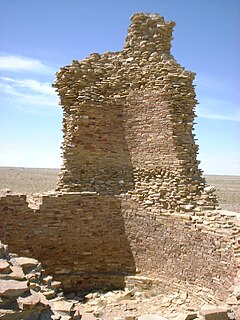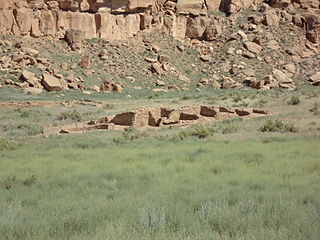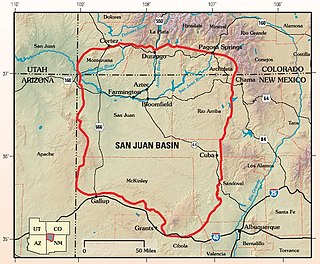
Pueblo del Arroyo is an Ancestral Puebloan great house and archaeological site located in Chaco Culture National Historical Park, in New Mexico, United States.

Kin Ya'a is a Chacoan great house and the center of a significant Ancestral Puebloan outlier community. It is located near Crownpoint, New Mexico on the Dutton Plateau, 25 miles (40 km) south of Chaco Canyon.
Escavada Wash is a tributary of the Chaco Wash, in Chaco Canyon, New Mexico, United States. It flows south and west from its origin near Lybrook, New Mexico, and meets the Chaco Wash at the west end of canyon. Several small Ancestral Puebloan archeological sites border the wash, which is located north of the Chacoan great house Pueblo Alto.

Shabik'eshchee Village is an archeological site located atop Chacra Mesa, New Mexico. Covering 20 acres (8.1 ha), the pit-house settlement was occupied c. 500–700 by Basketmaker III peoples. Discovered by Frank Roberts in 1926, the site is one of the earliest settlements in Chaco Canyon. Shabik'eshchee Village contained one hundred pit houses and a community great kiva. It is located approximately 9 miles (14 km) east of Pueblo Bonito.

A great house is a large, multi-storied Ancestral Puebloan structure; they were built between 850 and 1150. Archeologists differ as to their purpose, but they might have been residences for large numbers of people, or ceremonial centers that only priests occupied. Archeologist Stephen H. Lekson has proposed that they might have been the palaces of Puebloan royalty, particularly those found at Chaco Canyon.
Atlatl Cave is an important archeological site that contains organic evidence of occupation by Archaic North Americans c. 900 BCE. It is located at the west end of Chaco Canyon, New Mexico. During the 1970s, archeologists discovered plant material, a yucca fiber sandal, beads, basketry, and fabric made from rabbit fur in the cave. They also found part of an atlatl, or spear-thrower, from which the site got its name. Atlatl Cave is important because unlike most Archaic sites in the canyon, the shelter protected the organic materials inside, which allowed for accurate radiocarbon dating.

Small house refers to small masonry dwellings built by the Ancestral Puebloans. There are hundreds of small house sites in Chaco Canyon. They were first constructed during the late 8th and early 9th centuries, about fifty to seventy-five years before work began on great houses. They differ from great houses in that they do not feature core-and-veneer construction, nor do they include great kivas. Archeologists believe that the residents of small house sites were connected by marriage or kinship, and were part of larger communities based on association with nearby great houses.
Leyit Kin is an Ancestral Puebloan small house archeological site located 1 mile (1.6 km) southeast of Pueblo Bonito near the south end of Chaco Canyon in New Mexico, United States. Leyit Kin contains three kivas and twenty-seven rooms. It was occupied during three distinct periods ending in the late 12th century. The site was partially excavated in 1934 and 1936, but backfilling has made the structures nearly indistinguishable from the surrounding landscape.

Bis sa'ani is an Ancestral Puebloan great house and small house community and archeological site. Located in Chaco Canyon, New Mexico, United States, it contains thirty-five rooms and lies near the south of Escavada Wash 8 miles (13 km) from Pueblo Bonito. While outside the canyon, it is not considered an outlier, but included within the core group of ruins. There are several small house sites in the area, but no great kiva. Bis sa'ani was occupied during the early 11th century.
The Chaco Meridian is a theoretical north-south axis on which lie the Ancestral Puebloan sites, Aztec Ruins and Chaco Canyon, as well as Paquime at Casas Grandes in northern Mexico. Archeologist Stephen H. Lekson developed the theory, which suggests the location of these sites on the same approximate line of longitude (107°57'25") was intentional, and represents a ceremonial connection between them.
The Chacra Face Road is one of eight Ancestral Puebloan roads that enters Chaco Canyon, New Mexico. It enters the canyon through a break in the Chacra Mesa called the Fajada Gap, and ends at the great house Una Vida. It probably connected Una Vida to an eastern Puebloan community, Guadalupe Outlier.
East Community is an Ancestral Puebloan great house community and archeological site located 12 miles (19 km) east of Pueblo Bonito, at the eastern end of Chaco Culture National Historical Park, New Mexico. Archeological evidence uncovered during the 1980s suggests the site was occupied by both Chacoans and Mesa Verdeans. Eighty-two structures have been identified in the area, including a great house that contains twenty-five rooms and several small house sites. At least one kiva has been uncovered there, but no great kivas. A partial road segment is visible there, but archeologists are unsure of it connects with a longer segment thought to originate near Pueblo Pintado. The great house at East Community was constructed in the 10th century, with significant additions completed during the 11th century. The associated small house sites were occupied by Chacoans from 875 to 1300, and thirty-nine of them by Mesa Verdeans, from 1175 to 1300. Archeologist Thomas Windes believes the site was linked to Chaco Canyon through a system of signaling stations atop the area's mesas.

Halfway House Outlier is a small, twelve-room, one-story Ancestral Puebloan great house and archeological site located in New Mexico, United States. It lies halfway between Chaco Canyon and Salmon Ruins, on the Great North Road. Halfway House appears to have been built in relation to the road, and was probably an orientation point used during the road's construction.

The Great North Road is an Ancestral Puebloan road that stretches from Pueblo Alto, in Chaco Canyon, New Mexico, to Kutz Canyon in the northern portion of the San Juan Basin. It is thought to follow Kutz Canyon to the San Juan River and Salmon Ruins. Several archeological sites along the road are thought to have been ancient way stations, including Halfway House Outlier, Pierre's Outlier, and Twin Angels Outlier. The Great North Road is one of the best studied Chacoan roads, and includes four parallel roads along some segments, as well as low masonry features thought to be curbs. Herraduras are often found along segments of the road system.
Hosta Butte is an ancestral site in Chaco Culture National Historical Park, New Mexico. Along with Gobernador Knob and Huérfano Mountain, it forms part of the Dinétah, considered to be the birthplace of early Navajo culture. The mountain, with an elevation of 8,622 feet (2,628 m), is in close proximity to Crownpoint, New Mexico. Due to its prominence in the cosmography of Native tribes in the area, the mountain contains a number of small shrines. In 1877, photographer William Henry Jackson named the butte in honor of Francisco Hosta, who guided him to the Ancestral Puebloan ruins in Chaco Canyon.
Hillside Ruin is a large McElmo style great house and archeological site located near Pueblo Bonito in Chaco Culture National Historical Park, New Mexico. The mostly unexcavated building was occupied during the mid-12th century.
Hogback Outlier is an Ancestral Puebloan outlier community located 50 miles (80 km) northwest of Chaco Culture National Historical Park, New Mexico. The community features a great house, great kiva, and thirty-five small house sites.
Hubbard Site is an Ancestral Puebloan archeological site located in Aztec Ruins National Monument, New Mexico. The tri-wall structure, which resembles a similar building found at Pueblo del Arroyo, was excavated in 1953.
Lizard House is an Ancestral Puebloan small house located near Pueblo Bonito in Chaco Culture National Historical Park, New Mexico. Constructed in two phases, starting in the early 12th century, the site is an example of the changing Puebloan architecture of the 12th century.
Navajo Springs Outlier is an Ancestral Puebloan outlier community located 120 miles (190 km) southwest of Chaco Culture National Historical Park, New Mexico. The great house is one of the more westerly Chacoan pueblos. Three small house sites are located nearby, as are several midden piles. The site also contains a great kiva and seven berms. Two ancient roads connect portions of the site, which is protected by the Navajo Nation.











